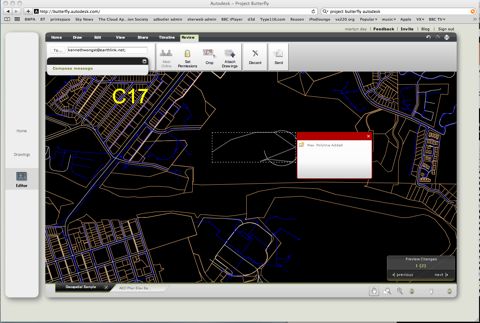
The battle to provide CAD tool online, in addition to the desktop took a step forward this month, with Autodesk unleashing Project Butterfly on its innovative Autodesk Labs website. Here users can try for free, a tool which allows the viewing, mark-up and editing of 2D DWG files, either solo or in realtime co-editing with a colleague. As the system is totally web-based the parties can be anywhere in the world and neither requires a copy of AutoCAD.
Previous cloud technology previews on the Labs website have been forthcoming new products, such as Project Dragonfly for room layout and more recently Project Twitch, to allow remote delivery of AutoCAD, Revit, Inventor and Maya (currently only available to those who live in US and Canada). Project Butterfly offers functionality similar to Autodesk View but the DWG files and the application are hosted on Autodesk’s servers and is accessed by a web browser. This means that drawings could be remotely stored, viewed, interrogated and marked-up on any PC with an Internet connection.
Once DWGs are added to the Project Butterfly servers, other users can be invited to view and edit DWGs online as well as download to their local computer. Two-party online review sessions can be held, where mark-ups can be added as well as notes made and stored. This first version also provides co-editing where two users can simultaneously create or delete geometry using familiar AutoCAD tools. For those who have used Google Wave, they will notice a similar philosophy.
Origin
Project Butterfly is the result of Autodesk acquiring PlanPlatform, a developer of Software-as-a-Service (SaaS) solutions based in Tel Aviv, Israel. The company was cofounded in 2007 by Jonathan Seroussi and Tal Weiss, who both used to work for Israel Aerospace Industries. PlanPLatform’s VisualTao product was demonstrated its beta DWG collaboration product early last year, after which Autodesk obviously took interest and completed acquisition in December 2009, for an estimated $20-$30 million.
In the drive to develop online CAD tools and a viable SaaS business Autodesk is evaluating a number of core technologies to get its products online, VisualTao is the latest. According to Autodesk CEO Carl Bass, there are four basic technologies currently under evaluation but he feels that there will be no one way, or single technology to deliver all the end-user experiences for cloud-based computing. Previously we have reported on Autodesk investment and testing of ‘onLive’ gaming technology which utilises cutting edge data compression algorithms to ‘squirt’ real time video over the web. OnLive is the technology behind the Project Twitter approach and relies of powerful servers to run the desktop applications on servers, sending the video and receiving keyboard and mouse input back over the web.
In both Project Dragonfly and Project Butterfly Autodesk uses Adobe’s Flash web engine, while we noted that Project Cooper (the potential LT version of AutoCAD LT) required the installation of Microsoft Silverlight. All these products have different ways of working and delivering the application experience over the web. Autodesk will use the best suited toolkits for each commercial product.
Project Butterfly is based on streaming technology but instead of dumb rendered graphics, sends accurate vectors and metadata using optimised compression, allowing for impressive CAD-like functionality and interaction within the browser. In use it does actually feel like a desktop CAD application. More CAD functionality is in the pipeline for Project Butterfly, together with the potential to handle 3D.
Future
Autodesk is clearly making the most of its Labs website to allow its customers to test out these new technologies. With everything from full AutoCAD or Inventor, home layout tools and now real-time collaboration delivered to a browser near you.
A full review of Project Butterfly will be up soon.






